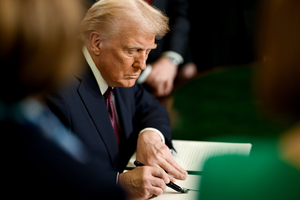Trump’s tariff war pits US geostrategic interests against Nobel pique, trade claims
By IANS | Updated: September 5, 2025 21:50 IST2025-09-05T21:48:23+5:302025-09-05T21:50:08+5:30
New York, Sept 5 While US President Donald Trump is seemingly on a warpath over a Nobel nomination ...

Trump’s tariff war pits US geostrategic interests against Nobel pique, trade claims
New York, Sept 5 While US President Donald Trump is seemingly on a warpath over a Nobel nomination and his commerce advisers over trade, Washington’s defence and diplomatic establishments are fighting a rearguard battle for safeguarding Washington's geostrategic interests, where India is a key player.
Just as Trump was attacking India on Tuesday, Indian and US troops were staging Exercise Yudh Abhyas in the Alaskan tundra, continuing a tradition set 21 years ago.
And a week earlier, the USS Frank Cable visited Chennai to practice with submarine INS Sindhuvijay how to repair subs.
Last month, Deputy Assistant Defence Secretary Andrew
Meanwhile, when Prime Minister Narendra Modi was coming home from China on Monday after meeting Presidents Vladimir Putin of Russia and Xi Jinping of China, the US Embassy in New Delhi launched a firefighting exercise.
It posted on X, “The partnership between the United States and India continues to reach new heights -- a defining relationship of the 21st century”.
Secretary of State Marco Rubio not only was on board, but on India’s Independence Day had said, "Our two countries are united by our shared vision for a more peaceful, prosperous, and secure Indo-Pacific region”.
The Indo-Pacific, where China looms large as a threat to the US and the world order, is the main factor behind the geostrategic interests that have bound the democracies in the “consequential and far-reaching” relationship to rise to the modern challenges”, as he said.
Senior defence and foreign relations of India and the US held their regular mid-year meeting at which they pledged their “eagerness to continue enhancing the breadth and depth of the bilateral relationship”.
They focused on "advanced bilateral initiatives, discussed regional security developments, and exchanged perspectives on a number of shared strategic priorities”, the US and India said.
The US Embassy’s X post added, “This month, we’re spotlighting the people, progress, and possibilities driving us forward. From innovation and entrepreneurship to defence and bilateral ties, it’s the enduring friendship between our two peoples that fuels this journey”.
Following that up, the US diplomatic representatives in India have been working overtime to boast about the range of cooperation between the two countries in fields as varied as crime-fighting and defence to space and start-ups.
Trump himself appears trapped in this dichotomy, “We get along with India very well”, he said on Tuesday, before launching one of his hyperbolic tirades about India’s high tariffs and Washington “foolishly” not charging duties.
On Wednesday in an unguarded moment, he let on his real reason for the punitive 25 per cent tariff on India for buying Russian oil: In an attempt to ward off criticism that he was soft on Russia, he was trying to create the impression that he was actually punishing Moscow by going after India.
Taunted by a reporter for a Polish media hinting at softness on Russia, he lashed out at him.
"How do you know there's no action? Would you say that putting secondary sanctions on India, the largest purchaser outside of China, they're almost equal, would you say there was no action? That cost hundreds of billions of dollars to Russia”, he said.
Despite conceding that China was the “largest purchaser”, he could not put the punitive tariffs on Beijing because of the US dependence on that country, not only for rare earths and magnets, but also for a lot of the citizens’ daily needs. Any action to disrupt the supply chain could lead to serious inflation and boomerang on him.
He also needs to go easy on Putin as he still hopes for his cooperation in ending the Ukraine War, on which he has staked his reputation and, therefore. cannot pile punishments on him.
The latest deadline giving two weeks from August 21 for making a peace deal or facing the threat of taking a “different tack” expired on Thursday with no action.
So, India becomes an easy target for the pretense of being hard on Putin.
Trump’s senior trade adviser Peter Navarro set the scene for this line of attack on India and diverting attention from Trump going easy on Russia and China.
It is now a tug of war between the realists of geostrategy and the fabulists of trade and ego, and Treasury Secretary Scott Bessent seemed to bet on the realists.
"I do think India's the world's largest democracy [and] the US is the world's largest economy. I think at the end of the day we will come together”, he said on the same day as Navarro’s diatribe last week.
Disclaimer: This post has been auto-published from an agency feed without any modifications to the text and has not been reviewed by an editor
Open in app